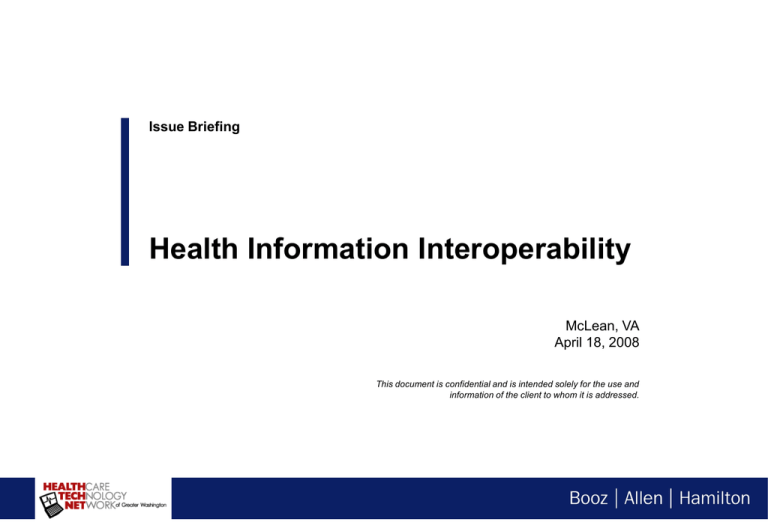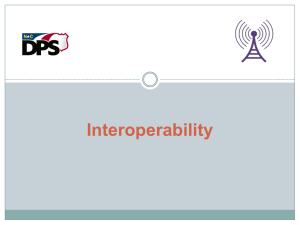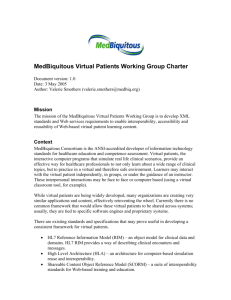BAH Interoperability Presentation
advertisement

Issue Briefing Health Information Interoperability McLean, VA April 18, 2008 This document is confidential and is intended solely for the use and information of the client to whom it is addressed. Table Of Contents The Interoperability Value Proposition Common Issues Key Components of Interoperability – National Initiatives – State/Local Initiatives – Private Sector Moving Forward caBIGTM Example 1 Interoperability is a critical component of the nation-wide implementation of health information technology… Interoperability; defined as the effective exchange of health information among diverse participants; advances high-quality, safe and efficient health care for patient and population health purposes – Patient focused health care -- moving electronic health information about an individual to where and when it is needed to support individual heath care and health care needs – Population health -- moving health information to support population-oriented uses such as public health, biomedical research, quality improvement, and emergency preparedness 2 …and has the potential to provide benefit to all stakeholders involved in the healthcare continuum. benefit from the capabilities to promote their own health and well-being by making informed choices in a safe and secure environment benefit from obtaining access to critical information needed to reduce medical errors and improve quality of health care and other organizations benefit from meaningful public health reporting, bioterrorism surveillance, quality monitoring, and advances in clinical trials benefit from the economic efficiencies, fewer errors, and reduced duplication that arise from interoperability benefit from streamlined processes, reduced redundancies, and as a result greater cost-efficiency 3 Table Of Contents The Interoperability Value Proposition Common Issues Key Components of Interoperability – National Initiatives – State/Local Initiatives – Private Sector Moving Forward caBIGTM Example 4 Federal and State governments face similar challenges in the adoption and creation of interoperable systems Lack of Standards Lack of Clearly Defined Value Proposition Numerous standards developing organizations currently exist, and although they are specific and comprehensive, there remain many overlaps and many gaps While specific and comprehensive messaging/transaction standards facilitate the exchange of data between systems, they do nothing to assure that the data will be understood and correctly interpreted by the receiving entity There are some conflicting goals of stakeholders who do not want to share information – sense of losing market share and customers. There are large investments that need to be made with unclear benefits for some stakeholders Security and Privacy Concerns Policy and Legal Concerns Individuals and organizations have many concerns about the inappropriate release or dissemination of personal and protected health information There are no standards around consent. and security and privacy issues; how do you manage preferences regarding opt-in and opt-out? HIPAA imposes requirements on all “covered entities” using health information “at rest” and “in motion,” this includes almost all health care providers in the United States Regulations surrounding the transmission of health information or recognition of consent varies state by state 5 Table Of Contents The Interoperability Value Proposition Common Issues Key Components of Interoperability – National Initiatives – State/Local Initiatives – Private Sector Moving Forward caBIGTM Example 6 A number of Federal initiatives related to priority setting, standards development and harmonization have been created The American Health Information Community (AHIC), was chartered to provide input and recommendations to HHS on how to accelerate the development of HIT, specifically how to make health records digital and interoperable The AHIC identified key focus areas for the advancement of standards that will lead to interoperability: – Chronic Care – Confidentiality, Privacy & Security – Consumer Empowerment – Electronic Health Records – Personalized Healthcare – Population Health and Clinical Care Connections – Quality http://www.hhs.gov/healthit/ahic 7 The Healthcare Information Technology Standards Panel (HITSP) was established due to the importance and need for interoperability The HITSP Mission: To harmonize relevant standards in the healthcare industry to enable and advance interoperability The standards harmonization process is an open, inclusive, collaborative, Use Case driven process www.hitsp.org HITSP functions as a partnership of the public and private sectors The objective is to achieve standards that will enable and support widespread interoperability among healthcare information technology systems The HITSP harmonization process is open, inclusive, and consensus driven HHS has formally recognized a set HITSP standards it received a year ago, now requiring federal agencies, by an executive order, to incorporate them into new systems or upgrades, or to buy products that comply with the standards. The work of HITSP is being implemented this year by the Nationwide Health Information Network (NHIN) Cooperative 8 The CCHIT accelerates the adoption of health IT by creating an efficient, credible and sustainable certification program The Certification Commission for Health Information Technology (CCHIT) was awarded a contract in 2005 from HHS Office of the National Coordinator to conduct two discrete activities – Establish the criteria and the process to determine the extent to which Electronic Health Record products can be certified as functionally useful within a care setting, and can be used as part of a nationwide health information network – Use the criteria and the process to examine and certify specific vendor products CCHIT is a recognized certification body that, to date, has established certification criteria for Ambulatory EHRs, Inpatient EHRs and a physicians guide on the value and importance of certification CCHIT volunteer Work Groups develop criteria and inspection processes for each domain – Ambulatory, Child Health, Emergency Department, Foundation, Inpatient, Secure Interoperability, Network, Privacy & Compliance, and System Security HITSP and CCHIT have aligned forces between interoperability specifications and functional criteria through the HITSP/CCHIT Joint Working Group 9 HISPC, a federal initiative, encourages interoperability through a collaboration of 42 states and territories to address security and privacy challenges of health information exchange The Health Information Security and Privacy Collaborative (HISPC) plays a key role in laying a policy groundwork to support widespread interoperable electronic health information exchange (HIE) Each participating state or territory looks to local stakeholders for input to ensure that proposed solutions are consistent and representative of local needs Each participating state is focused on a different “collaboratives” of security and privacy to try and develop “common, replicable, multistate solutions” that can then be applied nationally – Consent Laws – Harmonizing Privacy Laws – Consumer Education and Engagement – Provider Education – Adoption of Standards Policies – Inter-organizational Agreements http://privacysecurity.rti.org 10 Through funding and support from a variety of public and private entities, States and other organizations are advancing and promoting HIE development A variety of organizations understand the value and importance of promoting HIE at a local level The recent AHIMA FORE report indicates that there is significant HIE-related activity at the state/local level Many progressive states, such as Indiana, Tennessee, New York, Virginia, and North Carolina, are making strides toward statewide interoperability The AHIMA report concluded that publicprivate partnerships within states can assure consistency among all stakeholder perspectives while still maintaining a link with the national HIE objectives. http://www.ahima.org 11 Certain state wide initiatives are advancing rapidly to meet their HIE objectives Indiana Health Information Exchange has demonstrated interoperability with Community Health Network through the delivery of clinical results to primary care physicians – The EHR vendor has connected to 3 different practices, allowing the primary care physician to see care their patients receive in other hospitals or other hospital systems – Interoperability is the critical piece of the success of this system and provides more effective, time-efficient and quality care – Regenstrief and Indiana have created the nation's only citywide electronic medical records system New York has awarded $105.75 million in grants to promote interoperable health information technology across the state (HEAL Initiative) – Through this competitive grant process, the New York State Department of Health is investing in projects that are advancing interoperability – The strategic focus is to develop and implement New York's health information infrastructure effectively by utilizing clinical information, and enables clinicians through the availability of health information at the point of care http://www.health.state.ny.us http://www.ihie.com 12 New York is developing a health IT infrastructure through a common platform that embraces three components SHIN NY The New York architecture framework focuses on interoperability with the Statewide Health Information Network New York as a key component The New York Health IT Infrastructure has three components: Apply, Aggregate and Analyze, and Access 13 The private sector is contributing and participating in the interoperability of health information exchange as well American Health Insurance Plans (AHIP) – AHIP is pushing the adoption of standard data elements for personal health records (PHRs) to facilitate a portability model between health insurers – AHIP determined through collaboration with other payors the critical data sets necessary to allow easy transfer of information Dossia Corporation (AT&T, Applied Materials, BP, Intel, Pitney Bowes, Sanofi-Aventis and Wal-Mart) – A number of large companies have agreed to work together to build a database of health records for all of their employees – The health-records system called Dossia, will be able to supplement any data that an individual provides with records from hospitals, labs, pharmacies, insurance claims etc. Google – Google has launched a pilot project with the Cleveland Clinic to provide patients the results of their doctor visits, prescriptions, tests and procedures through Google's secure Web service – Designed to allow patients, medical providers and pharmacies to submit information to the records 14 Table Of Contents The Interoperability Value Proposition Common Issues Key Components of Interoperability – National Initiatives – State/Local Initiatives – Private Sector Moving Forward caBIGTM Example 15 Interoperability is important at all levels of the healthcare continuum Hospital perspective – A hospital that achieves Stage 6 still may not even be addressing issues related to interoperability – The aim is not to just focus on interoperability within an healthcare entity – the ultimate goal and ultimate utility of interoperability is realized when data is shared across the healthcare continuum Example: Public Health Situational Awareness – By increasing sources of clinical data, public health agencies are able to detect public health threats earlier and potentially save more lives 16 Table Of Contents The Interoperability Value Proposition Common Issues Key Components of Interoperability – National Initiatives – State/Local Initiatives – Private Sector Moving Forward caBIGTM Example 17 Value Proposition Example: Cancer Biomedical Informatics Grid (caBIG) Due to the lack of a common system for individual researchers or institutions to easily share data, researchers often operate in a near vacuum, or silo approach, without benefit of information from outside their institution. caBIGTM was built to connect cancer research communities through a shareable and interoperable infrastructure that required standards and common language to allow information to be easily exchanged caTRIP (Cancer Translational Research Informatics Platform) leverages multiple data repositories and allows users to query across a large number of caBIGTM data services. The initial focus is on outcome analysis which allows clinicians to query across data from existing patients with similar characteristics to find treatments that were administered with success. “An interoperable infrastructure will provides users with the ability to share tools and data to address cancer challenges in ways not currently possible” http://cabig.nci.nih.gov 18




